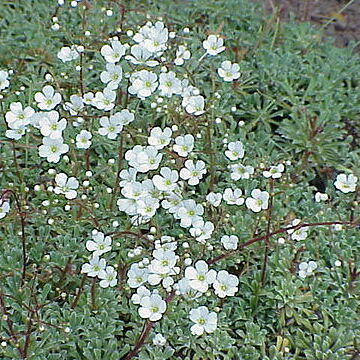Herbs perennial (biennial in S. adscendens, annual in S. tridactylites), sometimes rhizomatous, sometimes stoloniferous; caudex not fleshy, scaly, sometimes with bulbils; herbage hairy or stipitate-glandular, sometimes glabrous. Flowering stems ± erect, leafy, 1-40[-100] cm. Leaves in basal rosette and cauline, alternate (opposite in S. nathorstii, S. oppositifolia), cauline reduced; stipules absent; petiole absent or present; blade obovate, oblong, oblong-obovate, elliptic, linear, spatulate, or oblanceolate to ovate, reniform, or round, lobed or unlobed, base cuneate to cordate, ultimate margins entire, crenate, serrate, or dentate, (with lime-secreting hydathodes in S. aizoides, S. nathorstii, S. oppositifolia, S. paniculata), apex acute to obtuse or rounded; venation pinnate or palmate. Inflorescences thyrses or, sometimes, cymes, sometimes solitary flowers, terminal from terminal bud in rosette, 2-200[-1000]-flowered, (some or all flowers replaced by bulbils in S. cernua, S. mertensiana), usually bracteate (ebracteate in S. nathorstii, S. oppositifolia); (bracts leaflike). Flowers [bilaterally symmetric], bisexual (unisexual and plants sometimes gynodioecious, or plants dioecious in S. eschscholtzii); hypanthium free from or 1/4-3/4 adnate to ovary, free from ovary to 0.5 mm, green or pink to purple, (0.1-4 mm); sepals 5, green, sometimes reddish at tips, sometimes ± purple; petals absent or (1-)5, white, cream, yellow, orange, red, pink, or purple, often yellow-, orange-, or red-spotted; nectary disc present or not; stamens 10, (distinct); filaments linear and ± flattened (club-shaped in S. mertensiana); ovary superior to ± inferior, sometimes appearing more superior in fruit, 2-locular, carpels usually (1/4-)1/2 connate proximally or ± distinct; placentation axile (when connate 1/2+ their length) or appearing marginal; styles 2; stigmas 2. Capsules 2(-3)-beaked (± folliclelike in S. oppositifolia). Seeds brown, oblong, ellipsoid, or ovoid, smooth, tuberculate, or papillate. x = 6, 8, 11, 13, 14.
More
Herbs perennial, rarely annual or biennial. Stem cespitose or simple. Leaves both basal and cauline, petiolate or not; leaf blade simple, entire, margin dentate or lobate; cauline leaves usually alternate, rarely opposite. Inflorescence a solitary flower or few-to many-flowered cyme, bracteate. Flowers usually bisexual, sometimes unisexual, actinomorphic, rarely zygomorphic; receptacle cyathiform or saucer-shaped. Sepals (4 or)5(or 7 or 8). Petals (4 or)5, yellow, orange, white, or red to purple, callose or not, distinctly veined, margin usually entire. Stamens (8 or)10; filaments subulate or clavate. Carpels 2, usually connate at least in placental region; ovary superior to inferior, usually 2-loculed; placentation usually axile; ovules many; integuments 1 or 2; nectary disc sometimes well developed, annular or semiannular. Fruit a 2-valved capsule. Seeds many.
Fls perfect, regular or slightly irregular, 5-merous; hypanthium usually adnate to the base of the carpels, sometimes essentially free; pet mostly narrow; stamens 10; carpels mostly 2, connate at least at the base, with axile placentas, ripening into a bilobed capsule or nearly distinct follicles; perennial herbs with the principal lvs usually in basal rosettes or crowded on basal shoots, the flowering stem commonly with few or no lvs, the fls mostly in branched, cymose or cymose-paniculate infls, rarely solitary and terminal. (Antiphylla, Chondrosea, Hydatica, Leptasea, Micranthes) 350, Arctic, N. Temp., Andes.

